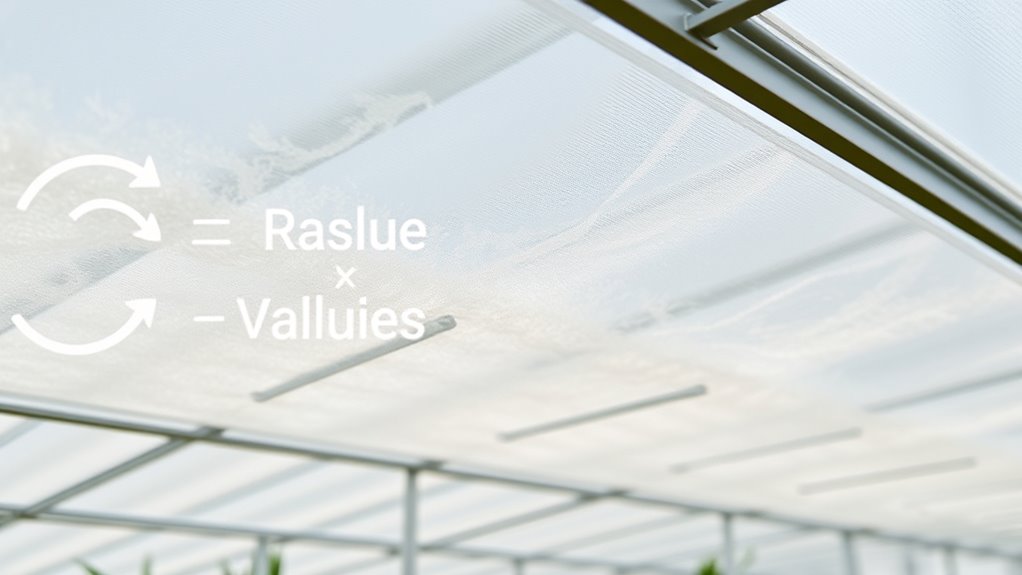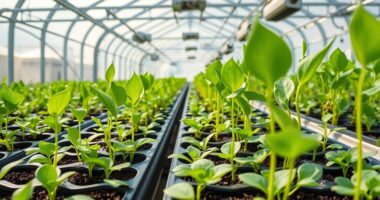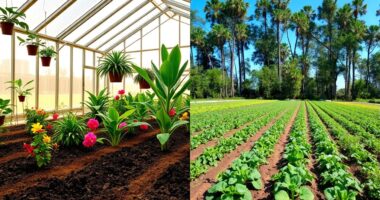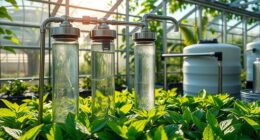Understanding R-value helps you choose the right insulation for your greenhouse by indicating how well it resists heat transfer. Higher R-values mean better insulation, which keeps your plants warmer and reduces energy costs. Proper installation and sealing are just as important as selecting the right material. Common options include foam boards and fiberglass, each suited to different climates. To optimize your greenhouse temperature control and efficiency, learning more about insulation strategies will give you the edge you need.
Key Takeaways
- R-value measures insulation’s resistance to heat transfer; higher R-values mean better thermal insulation.
- Common greenhouse insulation materials include foam boards, bubble wrap, fiberglass, and polycarbonate, each with different R-values.
- Proper installation, sealing gaps, and layering materials enhance insulation effectiveness and minimize heat loss.
- Insulation strategies should be tailored to climate, focusing on high R-values for colder regions and comprehensive sealing.
- Combining insulation with climate control systems improves temperature stability and reduces heating costs in greenhouses.
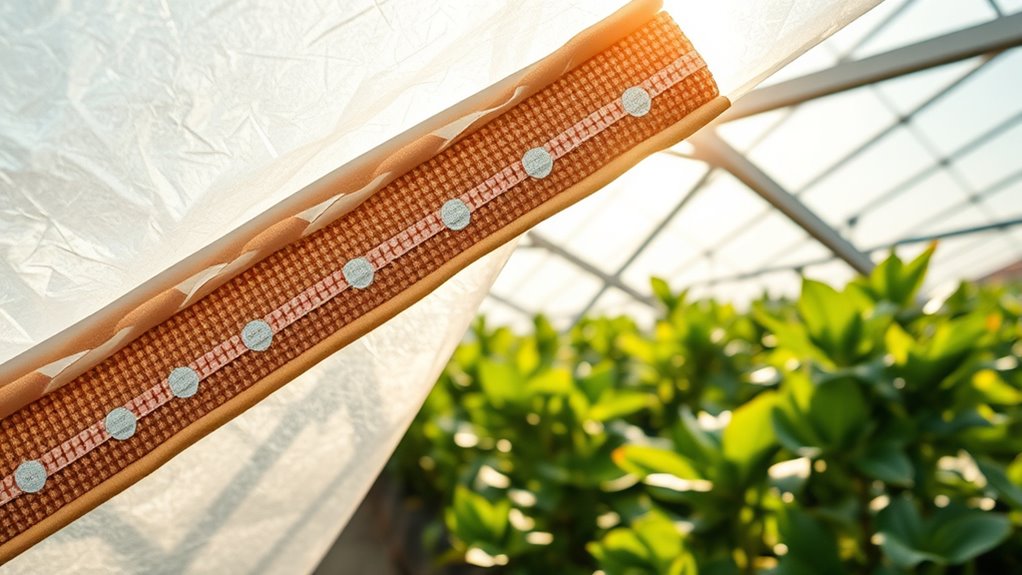
Have you ever wondered how well your greenhouse stays warm during cold months? The key lies in understanding R-value, which measures the thermal performance of insulation materials. R-value indicates how effectively a material resists heat transfer—higher values mean better insulation. When you select insulation for your greenhouse, you’re essentially choosing how well it can retain heat and keep your plants comfortable. This is especially important when temperatures drop outside, and maintaining a stable environment becomes vital for healthy growth.
The thermal performance of your greenhouse depends heavily on the insulation materials you use. Different materials offer varying R-values, so it’s essential to pick the right ones based on your climate and budget. Common options include foam boards, bubble wrap, fiberglass, and polycarbonate panels. Foam boards generally have high R-values per inch, making them excellent for insulating walls and ceilings. Bubble wrap, on the other hand, is lightweight and affordable, but provides a lower R-value, making it suitable for supplemental insulation or smaller gaps. Fiberglass insulation offers decent thermal performance and is widely available, while polycarbonate panels combine insulation with durability and light transmission, though their R-values may be lower than rigid foam options.
Understanding the R-value of each insulation material helps you maximize your greenhouse’s thermal performance. For colder regions, higher R-value materials are advisable to minimize heat loss. Proper installation is equally important because gaps or compression can reduce insulation efficiency. Sealing joints and edges prevents drafts that could compromise the thermal performance of your insulation setup. Additionally, layering different insulation materials can sometimes boost overall R-value and improve energy retention. Moreover, considering the best heat pump options for climate control can further enhance your greenhouse’s energy efficiency and temperature stability.
Maximize insulation effectiveness with proper installation, sealing gaps, and layering materials for better heat retention.
Keep in mind that the overall insulation strategy isn’t just about choosing materials with high R-values; it’s also about how you incorporate them into your greenhouse structure. Insulating windows, doors, and vents is just as important as insulating walls and ceilings. By focusing on the thermal performance of your insulation materials, you can create a more energy-efficient environment that reduces heating costs and protects your plants from freezing temperatures. Achieving an ideal R-value tailored to your specific needs means you’ll enjoy a warmer, more stable greenhouse environment during winter months. When you understand how insulation materials influence thermal performance, you gain control over your greenhouse’s climate, ensuring a thriving garden no matter how cold it gets outside.
Frequently Asked Questions
How Does R-Value Impact Greenhouse Energy Efficiency?
A higher R-value improves your greenhouse’s energy efficiency by providing better insulation, which reduces heat loss. When you focus on proper insulation installation and minimize thermal bridging, you can maximize this benefit. Good insulation keeps warmth inside during cold months and prevents overheating in summer. So, investing in high R-value materials and ensuring proper installation helps you save energy and creates a more stable, productive environment for your plants.
Can Insulation R-Value Change Over Time?
Yes, insulation R-value can change over time due to thermal degradation and insulation aging. As insulation materials age, exposure to moisture, temperature fluctuations, and UV rays can weaken their structure, reducing their effectiveness. This causes the R-value to decline, meaning your greenhouse may lose energy efficiency. Regular inspections and maintenance help identify when insulation needs upgrading or replacement, ensuring your greenhouse maintains ideal thermal performance.
What Is the Ideal R-Value for Different Climate Zones?
To thrive in your climate, target an R-value that tackles temperature and vapor barriers. In colder zones, aim for higher R-values, like R-20 or more, to block chill and curb condensation. Warmer areas need less insulation, around R-10 to R-15, to allow heat escape. Balancing thermal mass helps stabilize temperatures, while vapor barriers prevent moisture buildup, ensuring your greenhouse stays cozy and healthy across diverse climate zones.
How Do Different Insulation Materials Compare in R-Value?
You’ll find that foam board insulation has a high R-value, offering excellent thermal resistance and durability, but it can be pricier. Fiberglass insulation is more affordable and easy to install, though it may not last as long under moisture. Reflective foil insulates well in hot climates, with moderate durability and lower material costs. Consider your climate, budget, and durability needs to choose the best insulation material for your greenhouse.
Does Higher R-Value Insulation Affect Light Transmission?
Higher R-value insulation can reduce light transmission because thicker or denser materials tend to block more sunlight. If you choose insulation with a higher R-value, you might need to balance insulation thickness to maintain adequate light for your plants. Thicker insulation generally offers better thermal performance but can limit light. Consider selecting materials that provide a good R-value without markedly compromising light transmission to optimize your greenhouse environment.
Conclusion
Understanding the R-value helps you choose the right insulation for your greenhouse, ensuring efficient heat retention. While a higher R-value generally means better insulation, some experts argue that other factors like climate and ventilation also play vital roles. Don’t assume that a higher R-value guarantees ideal performance in all conditions. Instead, consider your specific environment and needs to make the most informed decision, balancing insulation with overall greenhouse design for the best results.
